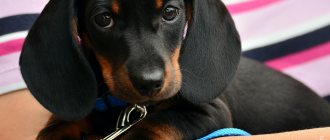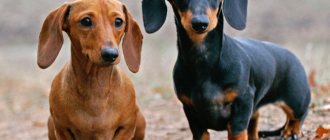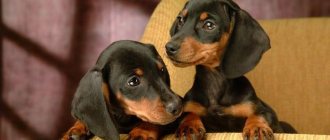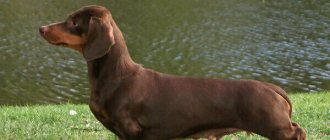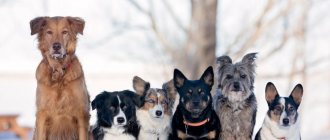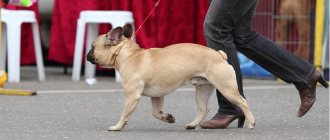Dachshund sizes
The dachshund is a small dog, this fact is known to everyone. However, the Dachshund breed includes as many as 9 varieties. The main criterion for dividing into subspecies is size; there are also additional criteria, such as the color of the pet and the type of its coat. According to the criterion of color, dachshunds belong either to the red variety, or to the merle variety, or to the category of tan dachshunds. The type of coat divides them into long-haired representatives of this breed, smooth-haired pets and wire-haired ones.
Dachshund - adult dog size
The size criterion plays a decisive role; it was especially important for breeders. The fact is that hunting, the original purpose of the small but fearless dachshund, required a certain body type. The oblong body, short legs and narrow, elongated muzzle were needed to extract living creatures, such as rabbits or foxes, from their tunnels and burrows underground.
At the dawn of the breed’s existence, dachshunds were all approximately the same size - standard, but over time it became necessary to slightly reduce the hunter’s four-legged companion - this is how the dwarf dachshund, and then the rabbit, arose.
Character and training
Infinitely smart and hard-working dogs, at times, show a very daring and uncontrollable character. The reasons always lie in the uncompensated hunting instinct that is inherent in the breed. The fact is that a small, smooth-haired dog is convenient for keeping in an apartment, and confinement within 4 walls and walking twice a day for 15 minutes in no way suits the Dachshund’s temperament.
What happens if your Dachshund can't meet his activity needs? In the easiest case, everything will result in damage to furniture or personal belongings. Escapes are a sore subject for Dachshund owners living in an apartment. The dog simply breaks away and runs “towards adventure”, ignoring the owner’s commands or his pursuit. In advanced cases, the four-legged animal searches for “fragrant” sources with the intention of wallowing. This act is associated with the desire to plunge into the wild essence of nature and smell like a hunter, that is, the earth, and sometimes feces, rot, rotten meat...
A properly raised dog that has the opportunity to run around and burn off energy brings joy to the owner and the whole family. Dachshunds distinguish between friends and strangers, so cats living in your home are not in danger. Rats, ferrets, birds and other animals can arouse hunting interest, but with the right approach on the part of the owner, the dog will get used to the strange neighbor. Relationships with children are going well; even the grumpy Dachshund is patient with the younger generation.
Representatives of the breed quickly learn any discipline, enjoy playing with their relatives and playing sports. Dachshunds also enjoy long, monotonous walks. According to reviews from successful owners, dogs adopt the pace of family life, but require daily exercise.
Individual characteristics of the breed
The advantage of any dachshund variety is its long lifespan. It is 15 years, which is quite unusual for short dogs with short legs, since their movement is associated with increased energy consumption. Moreover, the sparkling disposition and tirelessness characteristic of dachshunds also require additional energy, the source of which is high-quality nutrition with the addition of vitamins. With an insufficiently balanced diet, dachshunds will not be able to fully realize their energetic potential, showing lethargy and despondency. At the same time, feeding the dog in excess or giving it sweets is completely unacceptable if the owners do not want to end up with an overweight, sedentary pet.
But by providing him with healthy nutrition and the proper level of physical activity, owners will be able to fully experience the advantages of this breed - enthusiasm, enthusiasm and the ability to make friends. Neither children, with their eternal restlessness, nor adults, who prefer affection and fidelity, can resist the charm of dachshunds. The dachshund becomes a good companion for older people who are recommended to go for walks in the fresh air, which the dachshund will never refuse.
During walks, caring for the animal requires special attention. For example, a smooth-haired dachshund is more susceptible to freezing during the cold season, which means it needs clothing. The size of clothing for a dachshund is selected in accordance with the following parameters: it should not restrict the movement of a small hunter, and also should not be too spacious so as not to get tangled in the dachshund’s legs or crawl under the belly.
The charms of the Dachshund breed, which are equally good at any size, color and type of coat, can hardly be overestimated, therefore, becoming the owner and friend of this dog, a person receives an inexhaustible source of energy and love of life. It’s not for nothing that the classic of Russian literature – A.P. Chekhov was a passionate fan of dachshunds, keeping several pets of this breed at once. By the way, in Germany, the homeland of dachshunds, it is a national symbol and the hero of many children's rhymes and songs. Few breeds have won such wide recognition and adoration throughout the world, so the dachshund is rightfully considered one of the most popular and beloved dogs.
Maintenance and care
What is needed to keep a small dachshund? A house or bed where your pet will rest from daily affairs. A bowl, or better yet two. In one, Her Highness is served with food, and the other serves to quench her thirst.
Your pet will appreciate the toys. Anything that can be bitten and torn will definitely undergo face control. More precisely, “tooth control”. And how much dachshunds love balls cannot be expressed in words. Buy a rubber ball on a string. You'll see for yourself.
The dog needs housing. This is understandable: you can’t put such a baby in a booth, and you can’t put it in an outdoor enclosure either. In cold weather, the delicate animal freezes. And all sorts of bells and whistles have long been invented for representatives of the show class. That is, clothes for a dachshund.
Do you want to please your little one with a beautiful dress? No problem. Does your pet need a sweater or raincoat? Please choose. There are both coats and overalls for miniature dachshunds. There are so many things you can find in online dog clothing stores. For people, there is probably less choice than for their faithful four-legged companions.
Breed standard: weight and size of dachshund
The dachshund is an extraordinary, independent dog, but at the same time it is perfectly trainable in “skillful hands.” No matter how hard the whole world tried to forget this German breed, it didn’t work, how much time has passed, and the dachshund is again at the peak of its popularity.
Let's remember how the first dachshund appeared and find out the breed standard. For those who want to get this four-legged friend, we will advise you how to choose the right height and weight of a standard breed puppy. You will find out how much a healthy dachshund puppy weighs.
Origin story
Even in Egyptian cave paintings, a dog similar to a dachshund was depicted in all its glory; finds and mentions of this are in historical museums. This means that this is an ancient breed that has been loved and respected for a long time.
Although the hunting breed is not famous for its long legs like hound dogs, it is no less fast and agile. She will easily overtake any animal, and if it climbs into a hole, she will take out a trophy and present it to the owner.
The dachshund has no equal in burrow hunting for rodents. Previously, when it was expensive to own a pack of hounds, and such a privilege was enjoyed by the rich, dachshunds were owned by amateur hunters or self-sufficient people.
The weight and height of hound breeds was great, and keeping such an animal was also expensive. German breeders set to work, trying to reduce their size and create a unique breed capable of burrow hunting.
As a result of all these experiments, in the 16th century, such a breed as the “hunting marriage” was born. Its short legs were initially considered a defect, but after looking at the results of their work in practice, they began to carry out breeding selections to improve the quality of this breed.
Marriages a few years later began to be called dachshunds, and their standard was established in 1870. Today there are many dachshund standards in each country, one of them is adopted by the London Kennel Club, and the other by the FCI in Russia.
While the formation and standard of the breed was taking place, dachshunds changed their size, height and weight. They became more elongated and short-legged. The breed was depicted in artists' drawings, and famous people, such as Napoleon Bonaparte and many Russian figures, got dachshunds as life companions.
This is the first breed that has many varieties, dachshunds are divided by size, weight, and they also differ in the length of the coat and the animal, endurance and hunting ability.
Breed standard
Each country's breed standard is slightly different, consider the standard set by the Kennel Club for adult dachshunds:
- An elongated body, with muscular muscles, protruding chest. The chest is noticeably larger than the pelvis. The chest circumference can be used to determine size and weight.
- Head with an elongated muzzle resembling a cone, strong jaws, correct bite.
- Dachshunds' ears droop and almost reach the nose, fitting tightly to the cheeks;
- Squat build - short legs, spread to the sides like flippers, give the dog a comical appearance.
- The height of the dog varies for this standard, and ranges from 13 to 27 cm, and weight 4.5-12 kg.
- The tail is of medium length, continuing the line of the back.
- The eyes are medium-sized, almond-shaped, the color is often dark, but with light coat colors they can be lighter, as is the nose. The eyes are squinted, so the look sometimes seems sad.
- Balanced behavior, has a keen scent of a tracker, quick reaction and courage.
- An obedient dog, it trains well and adapts to humans.
- Adapted to burrow hunting and tracking prey.
- The gait is smooth and elegant, despite the height and stockiness.
How much does an adult dachshund weigh and what is its ideal weight?
The ideal weight for miniature dachshunds is 4.5 kg, while a standard dachshund weighs 9-12 kg. Interestingly, the UK standard does not allow dwarf parameters for this breed. Therefore, when purchasing a puppy, it is important to know how much the baby weighs; usually he weighs at least 2 kg at 2-3 months.
The Russian breed standard provides for another type - the dwarf (rabbit) dachshund, its weight is very tiny. But in FCI, size is calculated without paying special attention to height and weight, but by measuring chest circumference.
For a standard dachshund, the chest circumference is about 35 cm, for a miniature one - about 30-35 cm, and for a rabbit - up to 30 cm. Measurements are taken at the age of an adult dog, commensurate with the months of its life (no more and no less than 15).
Breed description, standards and appearance
The dachshund is a strong, heavily boned dog that stands firmly on the ground, with a long, elongated muzzle and long, soft ears. The tail, thick and strong at the base, is set low, usually carried slightly below the line of the back, but when excited it sticks out like an antenna. The main distinguishing feature is short thick legs with prominent muscles.
This is interesting! For several centuries, the high price allowed only royal and wealthy families to keep the breed.
The Dachshund standard approved by the FCI applies to all varieties:
Depending on the size of the dachshund there are:
- the weight of a boy’s dachshund ranges from 4–7 kg, and a girl’s – 3.5–6.5 kg;
- weight – less than 3.5 kg in dogs and less than 4 kg in dogs;
Important! The length of a dachshund depends on its type and height and ranges from 150-177 cm.
This is interesting! The Russian rabbit-type dachshund is a real rarity. The tiny size of this dachshund makes breeding difficult, so the number of breeders is kept to a minimum.
Depending on the species, a dachshund can have not only short and smooth hair, but also long and even fluffy hair.
Important! Smooth-haired and hairy dachshunds cannot be bred with each other. These are separate breeds.
Let's consider all the approved standards for the Dachshund breed depending on its coat type.
Coat type and color
Based on coat type, the breed is divided into the following varieties:
Depending on their color, dachshunds are:
Important! The white dachshund is not included in the standard. This color occurs when breeding rules are not followed or a natural anomaly occurs. Sometimes the white dachshund is an ordinary albino.
Buying a puppy, how to choose the right one
Since the Dachshund breed is very popular in Europe, you can buy it anywhere and in completely different price categories. We do not advise you to take risks by buying a puppy from your own hands; you could make a mistake and buy an aggressive dog.
After all, their behavior depends on the puppies’ living conditions; if they were not allowed outside and kept in an enclosure for a long time, their character may deteriorate and become contrary to the breed standard. It is better to choose your dachshund from a trusted nursery.
In addition, it is important to know how much the puppy weighs and at what age this is normal. The puppy grows up to 10 months, actively gains weight, and increases in body length. Accordingly, if the dachshund is standard, its weight may be equal to or slightly less than its age (monthly).
At 2 months, a puppy can already weigh 2 kg or 1.5 kg. It is important to pay attention to the proportions of the body - the length of the body should correspond to this scheme - 1: 1.8. Where 1 is the height at the withers, and 1.8 is the body length itself.
The English standard is characterized by a slight turn of the paws, while the Russian standard is characterized by a parallel stance. So, when choosing a puppy, pay attention to this aspect. The dog should not be aggressive or cowardly, actively get to know people and be interested in new smells and voice sounds.
The most important defects of any established standard are:
- A sunken chest, its volume should correspond to how much it weighs and age;
- Kozinets;
- Absence of fangs and incisors;
- Tail defects;
- Aggression, cowardice, apathy;
- The puppy weighs less than 1.5 kg at 2 months or more than 3 kg;
- Slow movements or shuffling paws are a sign of problems with the vertebra.
In whatever country you choose a dachshund puppy, you need to study the breed standard of that country, they are similar, but there are some differences. We tried to outline the theory, if not all, then give you more information for choosing the right pet.
The main thing when buying a puppy, do not forget to study its pedigree and raise it correctly, taking into account the independent nature of the breed.
Standard fee
Since the Dachshund breed is very popular in Europe, you can buy it anywhere and in completely different price categories. We do not advise you to take risks by buying a puppy from your own hands; you could make a mistake and buy an aggressive dog.
After all, their behavior depends on the puppies’ living conditions; if they were not allowed outside and kept in an enclosure for a long time, their character may deteriorate and become contrary to the breed standard. It is better to choose your dachshund from a trusted nursery.
We invite you to familiarize yourself with everything about the Jack Russell Terrier dog breed
In addition, it is important to know how much the puppy weighs and at what age this is normal. The puppy grows up to 10 months, actively gains weight, and increases in body length. Accordingly, if the dachshund is standard, its weight may be equal to or slightly less than its age (monthly).
At 2 months, a puppy can already weigh 2 kg or 1.5 kg. It is important to pay attention to the proportions of the body - the length of the body should correspond to this scheme - 1: 1.8. Where 1 is the height at the withers, and 1.8 is the body length itself.
The English standard is characterized by a slight turn of the paws, while the Russian standard is characterized by a parallel stance. So, when choosing a puppy, pay attention to this aspect. The dog should not be aggressive or cowardly, actively get to know people and be interested in new smells and voice sounds.
The most important defects of any established standard are:
- A sunken chest, its volume should correspond to how much it weighs and age;
- Kozinets;
- Absence of fangs and incisors;
- Tail defects;
- Aggression, cowardice, apathy;
- The puppy weighs less than 1.5 kg at 2 months or more than 3 kg;
- Slow movements or shuffling paws are a sign of problems with the vertebra.
In whatever country you choose a dachshund puppy, you need to study the breed standard of that country, they are similar, but there are some differences. We tried to outline the theory, if not all, then give you more information for choosing the right pet.
The main thing when buying a puppy, do not forget to study its pedigree and raise it correctly, taking into account the independent nature of the breed.
One of the most attractive things about miniature dachshund puppies is their tiny size and the fact that they remain quite small even after they grow up. All dachshunds are divided by size into 3 types, and in accordance with the standard, dogs are measured not so much by weight as by chest girth:
- Rabbit dachshunds - weight up to 3.5 kg, chest circumference up to 30 cm
- Miniature dachshunds - weight 4-7.0 kg, girth 30-35 cm
- Standard dachshunds - weight 7.5-15 kg, girth over 35 cm
Miniature Dachshunds have the same characteristics as Standard Dachshunds and Miniature Dachshunds, the main difference being their size. Maintenance
Photo of a dachshund puppy at 1 month
Photo of a dachshund puppy at 2 months
Photo of a dachshund puppy at 3 months
Photo of a dachshund puppy at 4 months
Photo of a dachshund puppy at 5 months
Photo of a dachshund puppy at 6 months
Photo of a dachshund puppy at 7 months
Photo of a dachshund puppy at 8 months
Photo of a dachshund puppy at 12 months (1 year)
Dachshunds begin aging at the age of eight, but much depends on the breed variety. Dwarf dachshunds are active and energetic until the age of 12; the standard dachshund is a medium-sized breed and begins to be lazy on walks at 8-10 years of age.
Scientists have proven that the smaller the breed, the faster it matures, but the slower it ages. Large dogs take longer to mature, but age several years earlier.
How long does a dachshund live by human standards?
| Dachshund age, years | Breed type | Person's age |
| 1 year | Standard | 10,5 |
| 1 year | Dwarf | 9 |
| 2 years | Standard | 15 |
| 2 years | Dwarf | 15 |
| 3 years | Standard | 20,5 |
| 3 years | Dwarf | 19,5 |
Next, for each year of the pet’s life, you need to add 4.5 years for the dwarf type and 5.5 for the standard variety of the breed.
A crucial moment in the life of the pet and the owner. Buy a baby from proven breeders with documents, do not take a puppy from the market - you risk getting a completely different breed of dog or a sick animal.
The baby grows up to 10 m of age, gains weight, it is not difficult to calculate the weight approximately corresponds to age, at 1.5 - 2 m the puppy will weigh from 1.5 to 2 and a little more than kg, but no less. Puppy dimensions in body proportions 1: 1.8 Height at withers – 1 Body length – 1.8.
The child should be inquisitive and not afraid of new acquaintances
a, taste you and actively respond to new smells and voice. Do not hesitate to ask about the baby’s parents, look at documents, find out the characteristics of the litter.
Dachshund weight by month - photos of puppies
One of the most attractive things about miniature dachshund puppies is their tiny size and the fact that they remain quite small even after they grow up. All dachshunds are divided by size into 3 types, and in accordance with the standard, dogs are measured not so much by weight as by chest girth:
- Rabbit dachshunds - weight up to 3.5 kg, chest circumference up to 30 cm
- Miniature dachshunds - weight 4-7.0 kg, girth 30-35 cm
- Standard dachshunds - weight 7.5-15 kg, girth over 35 cm
Miniature Dachshunds have the same characteristics as Standard Dachshunds and Miniature Dachshunds, the main difference being their size. Maintenance
Sizes of an adult standard, rabbit and miniature dachshund
The standard size for dachshunds is the chest volume:
- For an ordinary standard dachshund it will be over 35 cm
- For a dwarf - 30-35 cm
- In rabbit - up to 30 cm
Increase in standard rate:
- Males - 22-27 cm
- Females - 20-25 cm
Growth of the dwarf dachshund:
Growth of the rabbit dachshund:
- Males - 12-15 cm
- Females - 10-13 cm
All values are measured after 15 months . Apart from the size, nothing separates these dogs; the breed standard is the same for everyone. All dachshunds, regardless of size, must retain the characteristics inherent to the breed.
The dog should not look overly bulky or overly frail, like a weasel. Dachshunds have well-developed muscles and short, strong limbs.
The chest is wider than the waist. The transition from the chest to the moderately toned abdomen is smooth. The physique is very harmonious.
For dachshunds, consistency of all body proportions is very important. This is a rectangular dog.
The height of the withers to the length of the body should be 1:1.7-1.8, where 1 is the height at the withers, 1.7-1.8 is the length of the body, with an elongation index of 170-180%.
Standard Dachshund puppy weight table by month
| Age, month | Weight |
| Newborn puppy weight | 200-300 gr |
| Puppy weight 4 weeks (1 month) | 1.1-1.8 kg |
| Puppy weight at 2 months | 2.1-2.9 kg |
| Puppy weight at 3 months | 2.8-4.1 kg |
| Puppy weight at 4 months | 4.1-5.4 kg |
| Puppy weight at 5 months | 5.6-7.1 kg |
| Puppy weight at 6 months | 7.2-8.5 kg |
| Puppy weight at 10-12 months | 7.7-10.4 kg |
Like most newborn puppies, Dachshund puppies are tiny in size, weighing on average 200-250 grams in the case of the Miniature Dachshund. Dachshunds reach their full weight within 1 year. This is a really small dog that can be easily carried around. So if you want a pet that will fit on your lap, the Miniature Dachshund may be the breed for you.
Maintaining a healthy weight is important for all small dogs, and is especially necessary in the case of dachshunds due to their unusually long spine. Dachshunds have a long back and very short legs, which gives them the so-called “hot dog” body type. If they carry too much weight, additional stress will be placed on their spine, which can lead to injury. Additionally, Dachshunds should be assisted when climbing tall furniture or stairs because this also places significant additional pressure on the spine.
Dachshunds are an intelligent and friendly breed, and their size makes them great pets for apartment owners and anyone who doesn't have a strong desire to run around the park every day. Dachshunds need daily exercise, but a short walk will be more than enough.
Caring for dachshund puppies
Before purchasing a new pet, do not forget to prepare:
Up to 3 months, the dachshund is fed 4 times a day, from 3 to 8 months - 3 times a day, and after 8 months - 2 times a day like an adult dog.
Dachshund puppies feed on milk at 1 month. Mother's milk is replaced with cow's or goat's milk. After 2–3 months, porridge with chopped meat and vegetables is added to dairy and fermented milk products.
Important! Adult dogs develop lactose intolerance, so milk is only allowed for dachshund puppies.
For dry-fed dachshunds at 2 months old, the granules are soaked in water. After 5 months, the granules are served as usual.
When caring for puppies of this breed, it is important to follow a number of rules:
